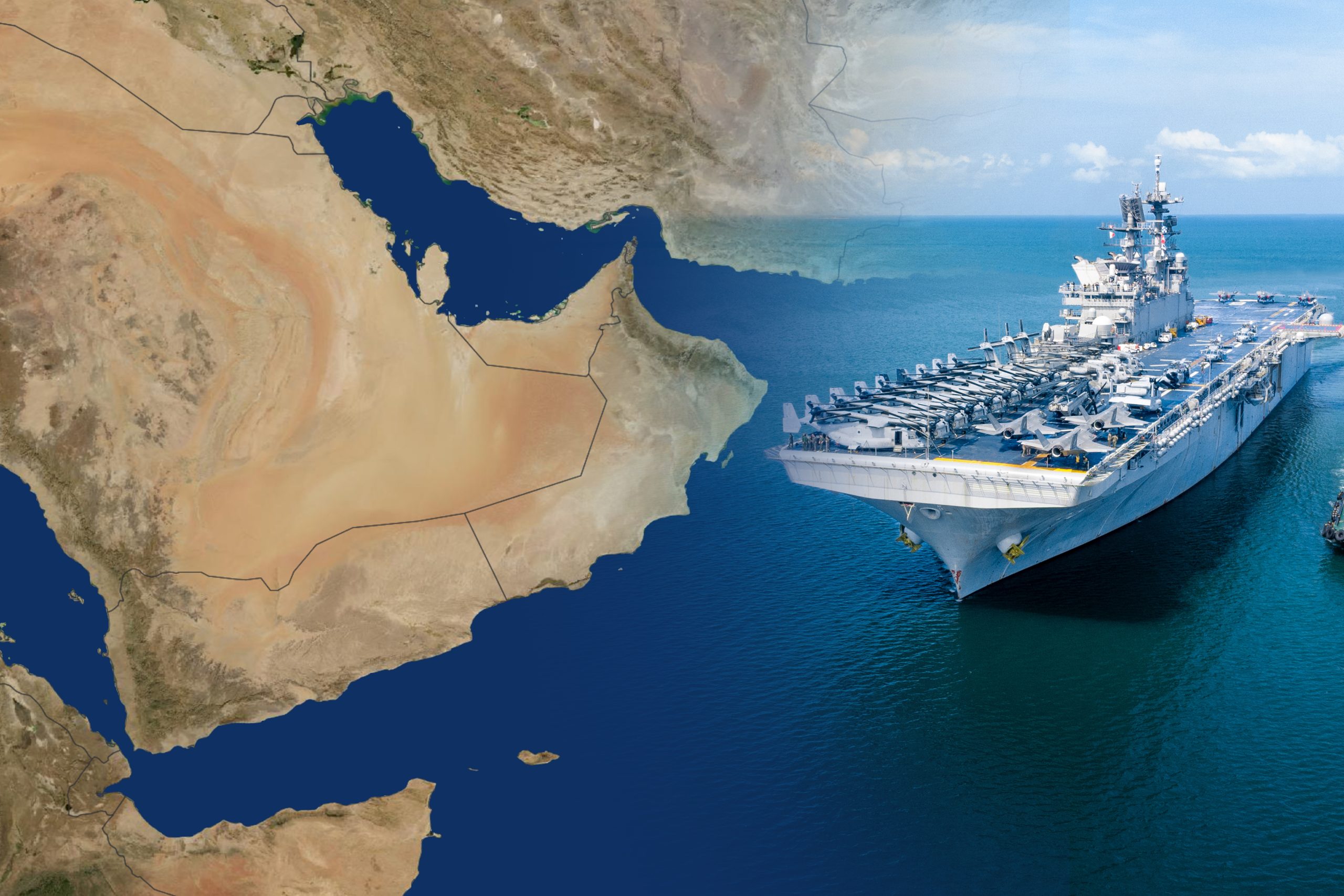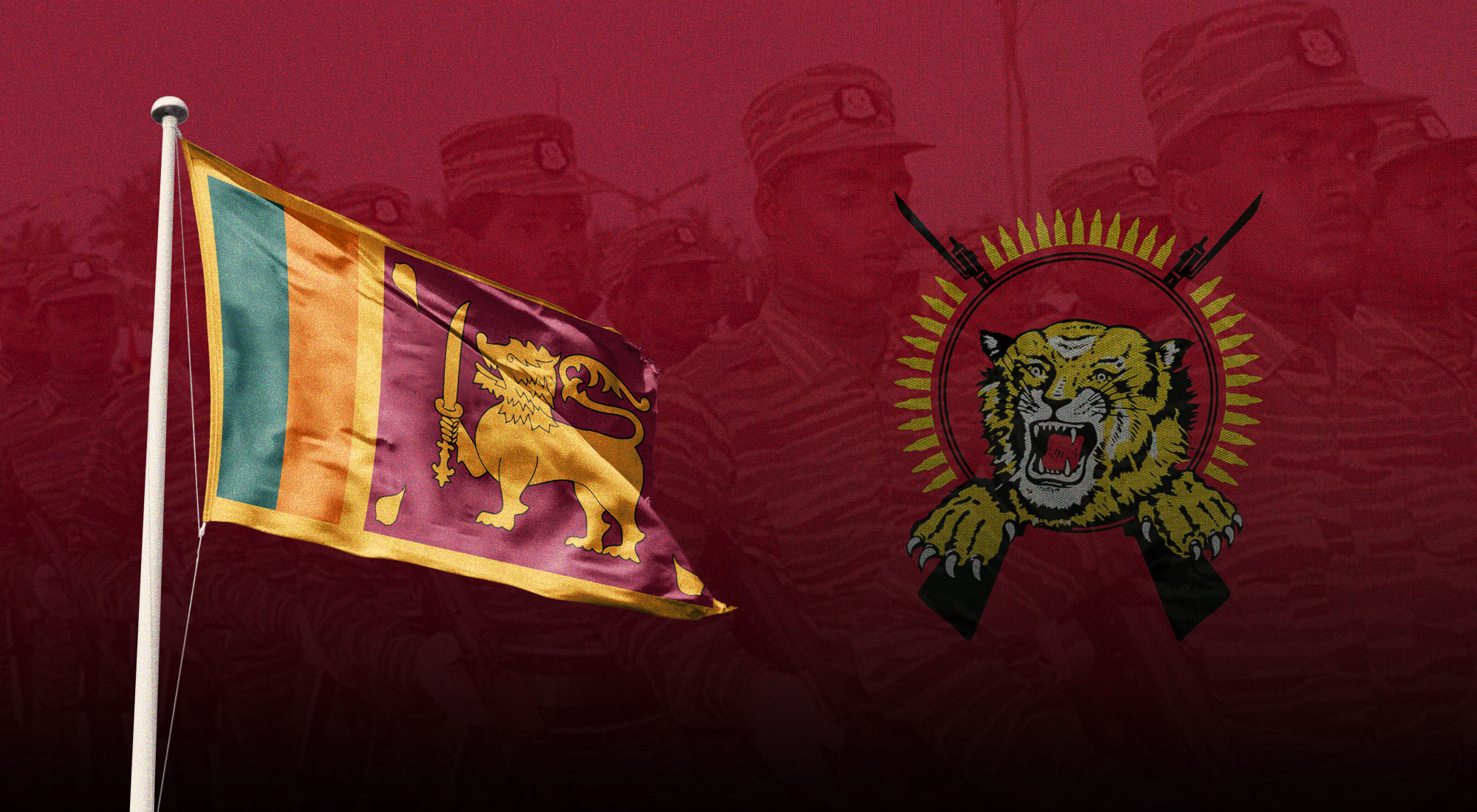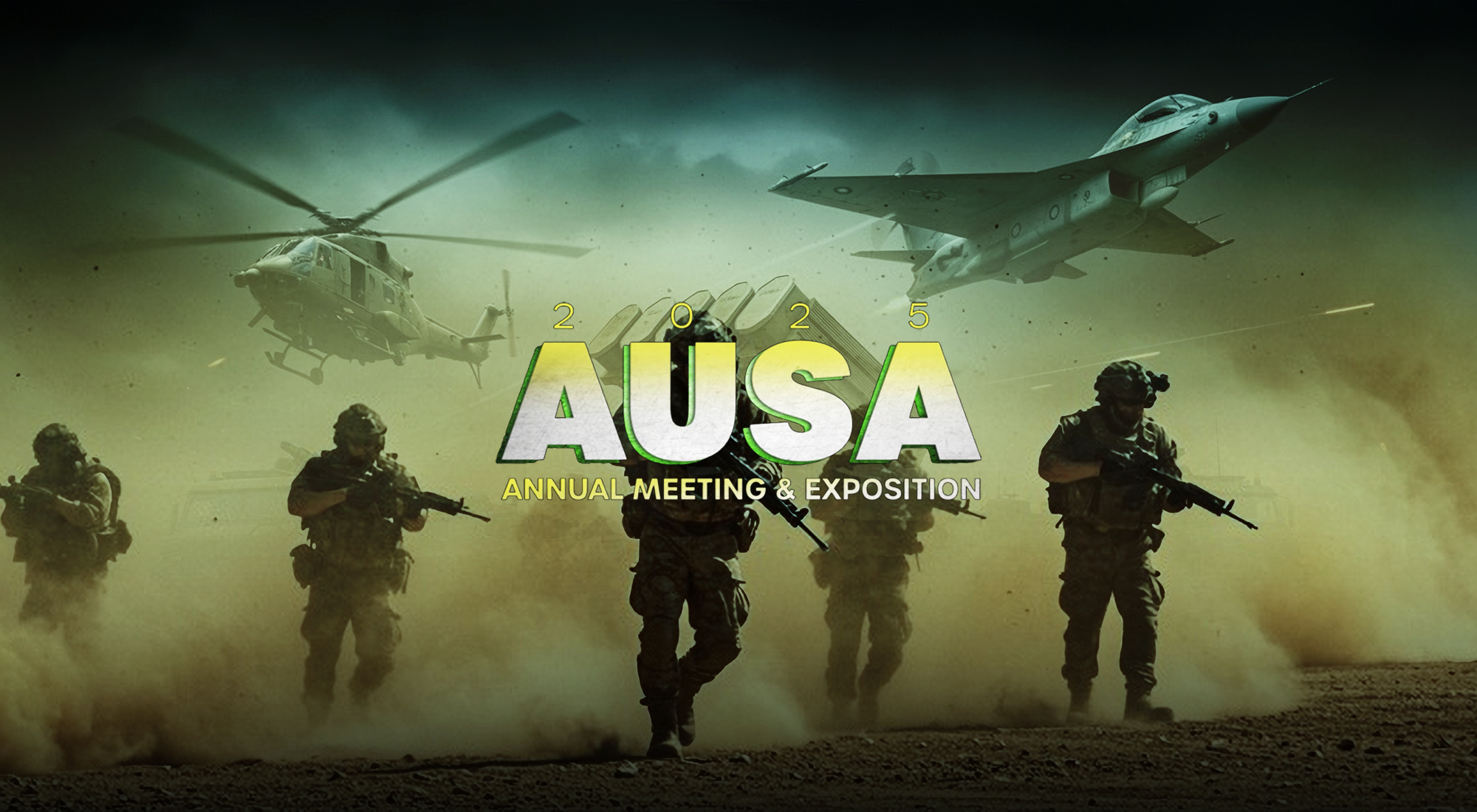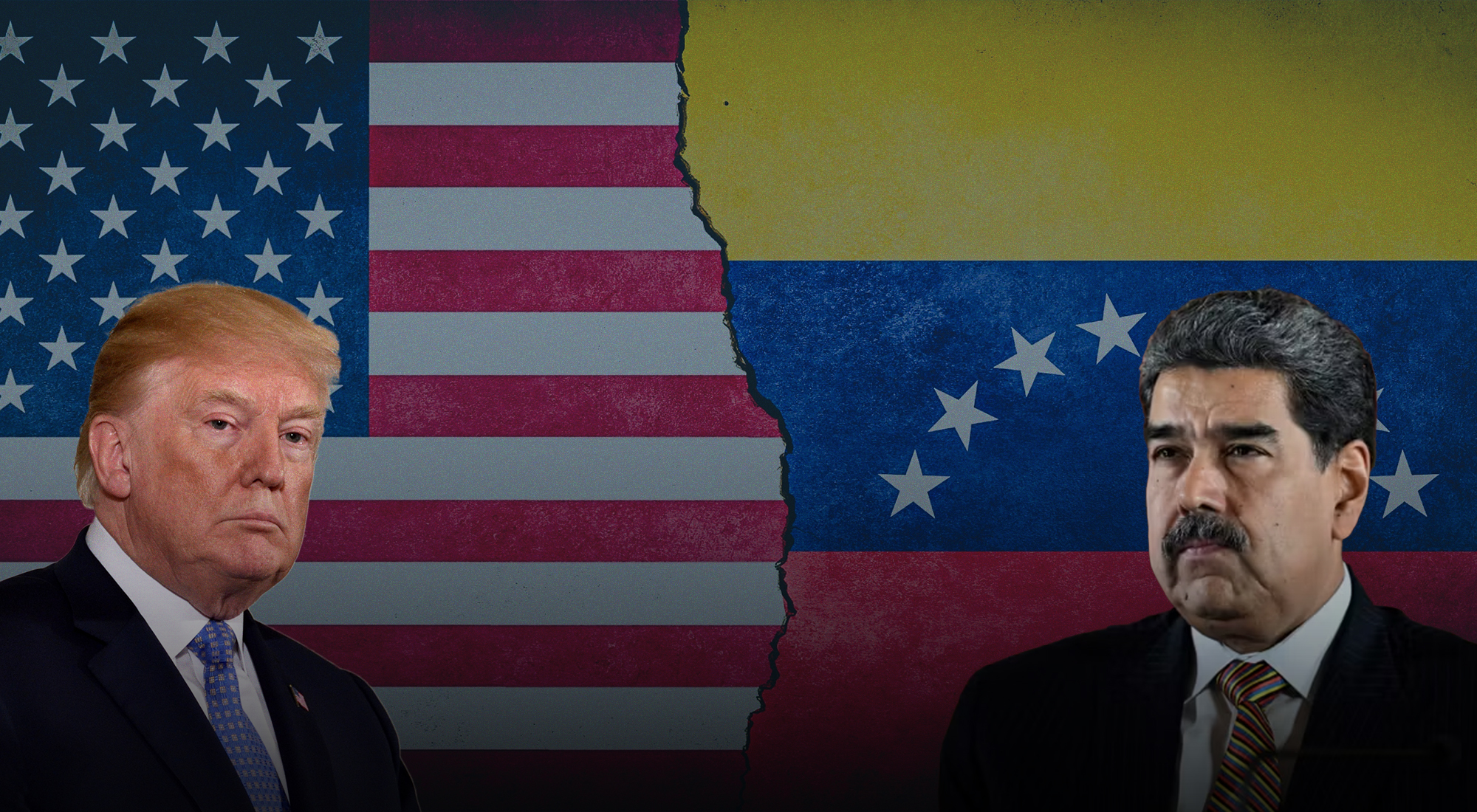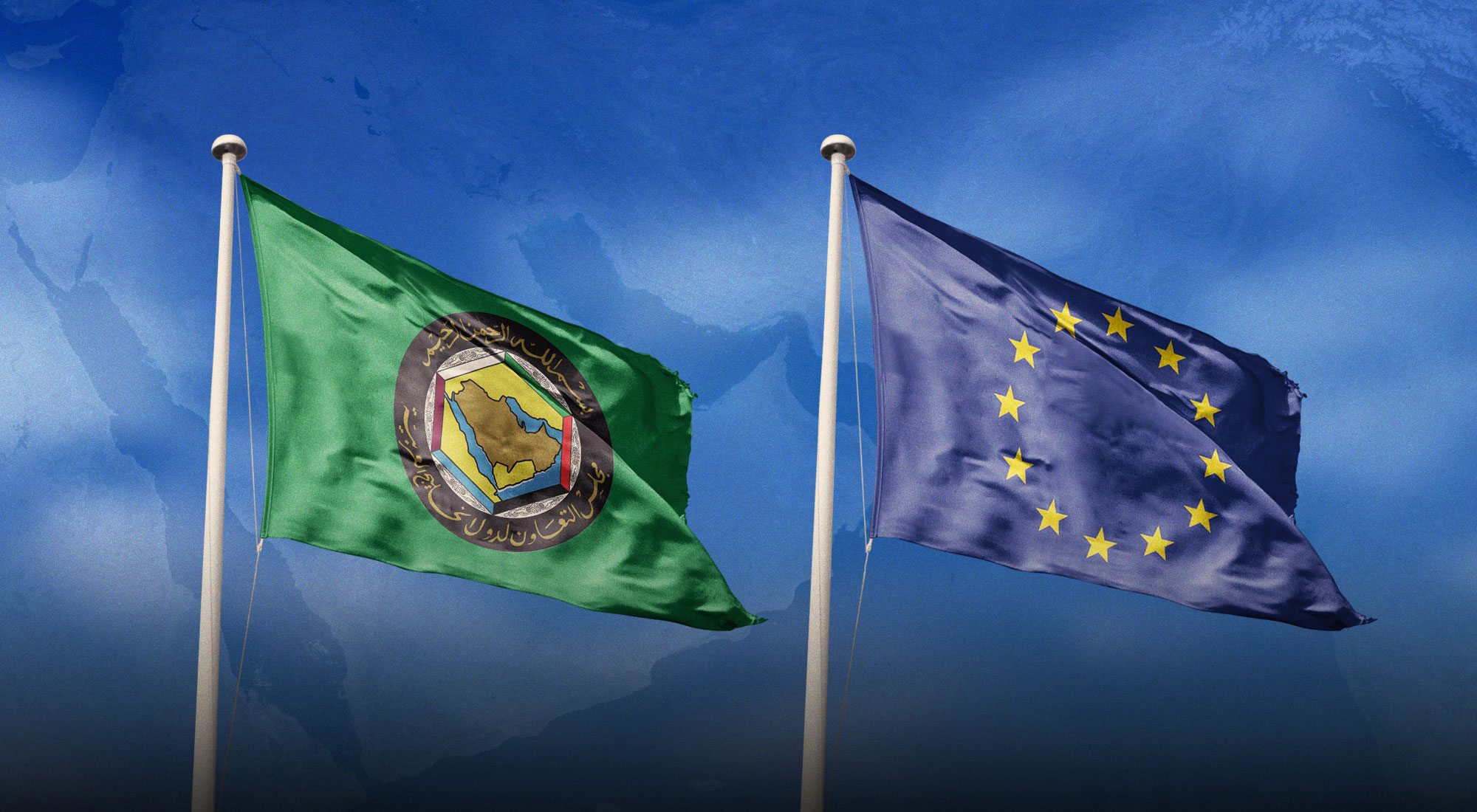Historically, the waters enclosed between the estuary of the Shatt Al Arab river and the Hormuz Strait have been a vital lifeline for civilizations developing along these littorals. From the dhows laden with the Silk Route’s riches and pearl-fishing vessels that used to sail across its waters in the past centuries, to the modern oil tankers and container ships that today contribute to making it one of the busiest global sea lanes, the Gulf waters have regularly attracted the attention and presence of seafarers. Strategically positioned amid three continents, the Gulf’s unique geography has turned it into a major commercial crossroad and a natural bridge connecting Europe, Africa, and Asia.[1]
Beyond oil: The Gulf as a gravitational center of the global economy
The discovery of rich fossil fuel deposits in the early 1930s rapidly turned the Gulf into the most productive extraction site globally. Since then, the region has become a leading producer of fossil fuels and a vital transit passage for energy supplies, refueling high-demanding markets in America, Europe, and Asia. In 2019, before the dip in global energy demand due to the Covid-19 pandemic, the daily flow of crude, condensate, and refined products across the Strait of Hormuz averaged around 21 million barrels per day.[2] With the rise in energy prices resulting from the post-pandemic economic recovery and the supply-shock induced by the Russian-Ukraine war, oil and gas revenues have rapidly bounced back to pre-pandemic levels and oil tanks have returned to populate global energy supply lines.
However, although the current scenario appears to promise highly remunerative returns and huge profit margins to oil and gas exporting countries, climate change-driven pressure to abandon fossil fuels and the need to adjust rentier-based economic systems to a post-oil era have induced Gulf littoral countries to rethink their economic model. While the outcome of this transition remains to be seen, the Gulf littoral countries seem set to move away from depleting resources for wealth generation towards never-depleting assets, such as geography. As Afshin Molavi, Senior Fellow at the Foreign Policy Institute of the Johns Hopkins University School of Advanced International Studies (SAIS), maintains, the key to fully unleash the geo-economic potential of the Gulf and ensure the long-term economic success of its littoral countries rests on the “strategic commercial geography” of the region.[3] The Gulf is a conduit of connectivity par excellence, a natural bridge between Europe, Africa, and Asia.
From Saudi Arabia[4] to Iran,[5] Gulf littoral countries have signaled a growing interest in capitalizing on their unique geography by investing in cutting-edge logistics and connectivity solutions, ports, and transport infrastructures. The strategic geography of the Gulf will outlive the oil and gas reserves that massively contributed to the economic prosperity of the littoral countries in the past. Therefore, even though its relevance as the leading global energy corridor might gradually decrease as a consequence of the progressive demise of fossil fuels, the Gulf is set to assert its role as a vital artery of seaborne commerce and is bound to remain a critical lifeline for coastal communities developing on its shorelines.[6]
Navigating narrow transit passages and shallow waters exposes vessels and seafarers to a wide array of threats from state-sponsored and non-state groups. The high concentration of energy and shipping infrastructures in a tiny, enclosed body of water such as the Gulf significantly increases the likelihood and magnitude of setbacks provoked by incidents at sea. Disruptions to trade and energy supply lines or forced closures of essential chokepoints, such as the Strait of Hormuz, would bear economic consequences reverberating far away from the epicenter of the crisis. When simmering political tensions among littoral countries are left unchecked and bilateral ties deteriorate, the risk of intentional or inadvertent armed escalation is at its highest. Therefore, although the Gulf’s geography is a never-depleting asset, the turmoil wreaking havoc in its immediate surroundings risks jeopardizing the geo-economic potential of this critical maritime space.
Back and forth from the abyss: Escalation and de-escalation in the Gulf waters
Since 1979, the shallow waters of the Gulf have regularly been a space of confrontation between the U.S. and Iran. Unsafe interactions and tense encounters between American warships and the Islamic Revolutionary Guard Corps Navy (IRGCN) have frequently increased tensions across the Strait of Hormuz. However, incidents in the Gulf experienced a skyrocketing surge in 2019, in the wake of then-President Donald Trump’s decision to withdraw from the Joint Comprehensive Plan of Action (JCPOA) and engage in the so-called “maximum pressure” strategy – an assertive foreign policy aimed at forcing Tehran to renegotiate a new nuclear deal under the pressure of harsh economic sanctions and diplomatic isolationism. Ultimately, the political uneasiness between Washington and Tehran spilled over into the Gulf, leading to a string of incidents involving several commercial ships navigating the Strait of Hormuz and the Gulf of Oman.
On May 12, an undetermined sabotage attack hit four oil tankers off the Fujairah coast. Although Iran denied involvement in the incident and the ships reported minimal hull damages, the dynamics of the event led observers to think that IRGCN might be behind it.[7] The Fujairah port is a strategic oil terminal on the Emirati coast facing the Indian Ocean, and it is a vital knot in the global energy supply line.
On June 13, the Panama-flagged Kokuka Courageous and the Marshall Islands-flagged Front Altair oil tankers suffered a similar destiny while navigating the Gulf of Oman and reported hull damages after being hit by what were suspected to be torpedoes. Although Iran promptly assisted the crews, the U.S. accused the IRGC of being the mastermind behind the incidents.[8]
On June 20, an Iranian surface-to-air missile launched from the IRGC Goruk base shot down a U.S. RQ-4 Global Hawk remotely-piloted aircraft conducting recognition operations over the Strait of Hormuz.[9]
On July 19, IRGCN speed boats intercepted the British-flagged oil tanker Stena Impero while crossing the Strait of Hormuz.[10] Boarded by helicopter-borne IRGC forces, the oil tanker and its crew were taken to the Iranian port of Bandar Abbas and held captive for more than two months until their release on September 27.[11] Although Iranian authorities claimed to legitimately seize the Stena Impero ship after a collision between the oil tanker and a fishing boat, the incident seemed to be a retaliatory action to the UK’s seizure of the Iranian tanker Adrian Darya-1 some weeks before. The Iranian ship was suspected of conducting smuggling activities in violation of the EU sanctions on Syria and was intercepted by the British Navy off the Gibraltar Strait.[12]
The at-sea harassment season culminated with the drone and missile attacks targeting the Saudi Aramco oil-processing facility at Abqaiq, on Saudi Arabia’s eastern coast, on September 14.[13] By knocking out around 6 percent of the global oil supply, this large-scale sabotage attack “represents the single largest daily oil supply disruption in history.”[14] The magnitude of the damages highlighted the mutual costs of allowing tensions to spiral out of control and the shared risks of having a heightened threat environment in the Gulf.
Most of the littoral countries have made significant efforts to scale back tensions to more manageable dimensions and have engaged in meaningful attempts to avoid full-scale escalations. The endeavors to lower the temperature across the Gulf have mainly taken the form of bilateral talks, primarily involving the coast guard of Iran and its Arab neighbors. In mid-April 2019, Oman and Iran held a six-day joint meeting to enhance cooperation at sea. While Iranian and Omani naval forces held rescue and relief drills in the Gulf of Oman, diplomatic delegations from both sides signed a memorandum of understanding on military cooperation.[15] At the end of July 2019, Emirati and Iranian coast guard authorities met in Tehran to discuss mutual concerns surrounding maritime security.[16] In mid-August 2019, the then-President of Iran, Hassan Rouhani, and the Emir of Qatar, Sheikh Tamim bin Hamad Al Thani, had a phone conversation about the importance of preserving the stability and security of the Gulf’s sea lanes.[17]
However, although the de-escalatory shift seems to hold, localized episodes of violence at sea and arbitrary use of force still occasionally occur. On May 27, 2022, the IRGCN seized two Greek-flagged oil tankers, the Delta Poseidon and the Prudent Warrior. The detention of the ships by Iranian authorities could be read as a retaliatory response to Greece’s role in the U.S. seizure of the Iranian-flagged tanker Lana in the Aegean Sea a month before.[18] Three months later, on August 29, the IRGCN’s support ship Shahid Baziar attempted to seize a U.S. Saildrone Explorer Unmanned Surface Vessel (USV) transiting the Gulf waters. However, the rapid intervention of the U.S. Navy patrol coastal ship USS Thunderbolt (PC12) and an MH-60S Seahawk helicopter induced the Iranian ship to release the USV.[19]
While these are isolated cases, the latest episodes display a regular pattern in Iran’s security posture and sheds light on two lessons of paramount importance about Gulf maritime security. First, when threatened, Tehran tends to react by retaliating in a tit-for-tat manner or engaging in hazardous acts of sabotage. As Dr. Abdolrasool Divsallar, a non-resident scholar at the Middle East Institute, affirms: “The leadership in the Islamic Republic is convinced that it is beneficial to strategically adjust with existential threats through having a willingness of taking a calculated risk and respond in kind.”[20] Second, the Gulf remains a contested space, a zone of tense confrontation between Tehran and its rivals. Zooming in on the pattern of incidents at sea, Iran seems reluctant to abandon its risk-taking attitude for a multi-faceted number of factors. On the one hand, Iran occasionally flares up tensions in the Gulf waters to remind its neighbors that it still preserves a strong will and the material capability to conduct targeted strikes and sabotage operations. Indeed, through these irregular shows of force, Tehran aims to signal that its political commitment and tactical reactivity remain unaltered. On the other hand, the fact that no major military action against Iran followed these episodes of violence emboldened the perception among the Iranian political and military leadership that Tehran can go to great lengths to project force in the Gulf without facing immediate retaliation by its competitors. The lack of retaliation has a twofold reason. First, as Dr. Farzin Nadimi, an associate fellow with The Washington Institute for Near East Policy, affirms, Western powers have developed a “substantially higher tolerance threshold”[21] to Iranian malign activities at sea. Second, Iran has built up an effective and credible military deterrent that disincentivizes Arab Gulf countries to respond in kind to Iran’s aggressions.
Although a shared consensus among littoral countries in preserving order and security in the Gulf waters seems to have taken shape over the last years, this precarious stability might quickly get out of hand and lead to accidental military escalations.
Foreign approaches to a regional dilemma
The intensification of incidents at sea prompted the U.S. and some like-minded states – the United Kingdom, Bahrain, and Australia – to launch, in July 2019, the International Maritime Security Construct (IMSC), a military coalition aimed at promoting free navigation for commercial vessels crossing international waters off the Arabian Peninsula.[22] Four months later, the IMSC inaugurated its operative arm, the Coalition Task Force (CTF) Sentinel, and opened its command center in Manama, Bahrain, where the U.S. Naval Forces Central Command (NAVCENT) and the U.S. Fifth Fleet are also headquartered.[23] CTF Sentinel’s primary goals are to reassure container ships and oil tankers while navigating in the IMSC’s operational area and to deter aggressions by hostile actors by conducting surveillance and patrolling missions.[24] Soon after its inauguration, regional stakeholders, Saudi Arabia and the UAE, and a European partner, Albania, joined the security platform. IMSC generally deploys a composite array of military assets, including large naval vessels, such as frigates and destroyers, smaller ships, such as patrol boats and corvettes, and aerial assets, such as surveillance aircraft, helicopters, and drones. In addition to IMSC’s founding members and early participants, three more states – Lithuania, Estonia, and Romania – have joined the U.S.-led maritime security construct. With Australia placing its contribution on hold at the end of 2020, the IMSC currently features nine member states.
Since its establishment, CTF Sentinel has significantly contributed to promoting a more secure maritime space in the Gulf waters, by making roughly 10,000 maritime awareness calls and providing overwatch to over 1,100 partner nation-flagged commercial ships.[25] Beyond surveillance and monitoring operations, CTF Sentinel has boosted the operational readiness and interoperability capacity of the coalition’s forces by regularly organizing maritime drills. Since January 2022, CTF Sentinel has successfully conducted five combined naval exercises – known as Sentinel Shield – to test the coalition’s deterrence capabilities. The latest iteration took place on August 23 and featured the participation of the Bahraini patrol boat RBNS Ahmed Al-Fateh (P20) and the U.S. Coast Guard patrol boat USCGC Baranof (WPB 1318). Aside from engaging in synchronized tactical maneuvers, the exercise stands out for the integration of a U.S. Saildrone Explorer USV, a development that the USCGC Baranof’s Commanding Officer, Lieutenant Vaughn Gehman, considers “a force-multiplier for IMSC and its ability to detect and deter malign activity.”[26]
Although the IMSC claimed not to serve any strategic purpose other than to promote maritime surveillance and deterrence, Washington’s drive behind it and the coincidence in time between its inauguration and the intensification of U.S. economic sanctions on Iran led many observers to perceive CTF Sentinel as the military component of then-President Trump’s “maximum pressure” strategy. Even if not in words, the IMSC led to a growing uneasiness among some European states.
Against the backdrop of the perceived anti-Iranian posture of the IMSC and the need to continue a positive engagement with the Iranian leadership in Tehran, a France-led naval initiative, known as European Maritime Awareness in the Strait of Hormuz (EMASoH), gradually took shape in the Gulf region. Inaugurated in January 2020, under a strong French drive, EMASoH gained the political support of other seven European states – Belgium, Denmark, Germany, Greece, Italy, Portugal, and the Netherlands – sharing a vested interest in promoting “enhanced de-escalation initiatives” aimed at defusing tensions wreaking havoc in the Gulf and the Strait of Hormuz.[27]
As CTF Sentinel represents IMSC’s operative arm, Operation Agénor is EMASoH’s military track. Headquartered at Camp de la Paix, a French military facility in Abu Dhabi, UAE, Operation Agénor combines a mix of naval and air assets: generally two warships – such as corvettes, frigates, or offshore patrol vessels (OPVs) – and one maritime patrol aircraft (MPA). The Italian OPV Thaon di Revel (P430), the French La Fayette-class frigate Guépratte, and a French MPA crew are the spearheads of EMASoH’s forward-deployed naval forces at the moment. To escort commercial ships through the Strait of Hormuz, keep day-to-day interface with shipping industry stakeholders, and ensure information sharing with other maritime security initiatives active in the area feature among Operation Agénor’s primary tasks.
Despite its limited naval assets, EMASoH represents a concrete display of the growing interest and closer attention paid by the European countries to the Gulf and its geopolitical undercurrents. This trend was further reinforced by the EU’s decision issued in February 2022 to extend the Coordinated Maritime Presences (CMP) concept to the North-Western Indian Ocean and establish it as an EU Maritime Area of Interest.[28] In brief, the CMP is a tool aimed at strengthening the EU’s engagement in the maritime security domain, specifically in the water spaces identified by Brussels as areas of strategic relevance to EU member states, by ensuring, among other things, the permanent presence of EU navies and greater operational engagement among them.[29] Last but not least, the EU released in mid-May 2022, a programmatic document – called “A Strategic Partnership with the Gulf” – outlining mutual areas of interest between the two regional organizations and defining the steps to take in order to fully activate a meaningful partnership between the EU and the GCC. Among the most relevant fields of cooperation, fostering joint solutions “on maritime safety, environmental protection and maritime transport interconnections”[30] emerges as a priority in the EU’s roadmap to develop deeper ties with its Gulf partners.
The latest moves of Brussels in bridging the distance between the EU and the GCC tell a story of growing resolve by the EU states to develop a comprehensive, integrated, and multi-layered security framework in the Gulf and its neighboring waters. As the Strategic Partnership with the Gulf document maintains, the EU is committed to “develop a cooperation mechanism for enhanced maritime security, building on Operation ATALANTA, EMASoH and the Coordinated Maritime Presence in the North Western Indian Ocean.”[31] On that note, it is worth mentioning that it is already common practice among European warships dispatched to the Middle East to prolong their deployment to the region by rotating their services between Operation Agénor and Operation Atalanta, an EU mission devoted to counter-piracy and maritime awareness in the Horn of Africa.
Although IMSC and EMASoH have contributed significantly to de-escalating tensions across the Strait of Hormuz, by providing credible reassurances to seafarers and building credible deterrence against malicious activities menacing commercial ships, the two initiatives have achieved only limited results in creating a comprehensive maritime security community in the Gulf region. Indeed, even though IMSC and EMASoH concur that ensuring freedom of navigation in the Gulf waters is a primary goal of their mandate, the two military coalitions keep inter-operation cooperation at minimal levels.
Although there is some coordination between them, mainly in information sharing and occasional meetings, the overall approach remains quite fragmented. In this regard, the fact that the two military constructs are the outcome of different political contexts and respond to different domestic strategic calculus has so far compromised the achievement of meaningful, in-depth cohesion among these initiatives. Consequently, as confidence in the capacity of the U.S. and European military operations to keep up with increasing security threats teeters, some Arab Gulf countries – such as Saudi Arabia and the UAE – have signaled a growing interest in developing efficient naval assets and boosting their own maritime combat readiness.
High targets and practical constraints: Saudi and Emirati homegrown solutions to maritime insecurity
With most of its warships dating back to military purchases made in the 1980s and 1990s, Saudi Arabia has recently inaugurated an ambitious, comprehensive project – known as the Saudi Naval Expansion Programme II (SNEP II) – to renovate and modernize its aging fleets.[32] Inaugurated in April 2022 at the Spanish Naval Base of La Carraca in the Bay of Cadiz,[33] the Al Jubail Avante 2200-class corvette finally docked at the King Faisal Naval Base in southern Jeddah on August 25, 2022.[34] The Al Jubail warship is the first of five corvettes that the Royal Saudi Navy (RSN) commissioned to the Spanish shipbuilder Navantia in 2018 within the Sarawat Corvette project: an initiative that, in addition to the construction of warships, also features cooperation between Navantia and RSN in the training of crews as well as long-term technical and logistical support.[35]
The Avante 2200-class corvette is a next-generation warship with high-end weaponry systems, making it a naval asset capable of countering air, surface, and underwater threats and performing electronic warfare. It is worth noting that the five Navantia-made corvettes are set to become the RSN’s most technologically-advanced surface vessels and a symbol of national pride since they are equipped with the HAZEM Combat Management System (CMS), the first Saudi-developed maritime battle operations system.[36] Realized by a joint venture between the Saudi Arabian Military Industries Company (SAMI) and Navantia, the HAZEM CMS reflects a solid commitment to reducing the country’s reliance on foreign arms providers by developing homo-grown military and defense solutions.
Other high-end naval and air assets to boost the RSN’s force projection at sea are the Lockheed Martin Multi-Mission Surface Combatant (MMSC) ship and the Sikorsky MH-60/MH60R Seahawk helicopter. With a range of 5,000 nautical miles, a maximum speed of over 30 knots, and equipped with advanced weaponry systems, the MMSC ship is a highly versatile vessel capable of operating in littoral and open ocean combat scenarios. The RSN placed an order totaling US$450 million with Lockheed Martin and Fincantieri to construct four MMSC ships in mid-2018.[37] The MMSC ship’s operational capabilities are significantly improved when deployed with a Seahawk helicopter, widely recognized as a force-maximizer for warships conducting anti-submarine and anti-surface warfare. In 2015, RSN placed an order of US$2 billion with Lockheed Martin to produce ten Seahawk helicopters.[38]
On May 13, 2022, the UAE launched the second 2500 Gowind corvette, Al Emarat, at Lorient shipyard in northern France. The ship’s inauguration ceremony completed the US$850 million-worth contract signed in 2019 between the Emirati Navy and the French warship-builder Naval Group to provide two state-of-the-art corvettes. The first corvette, Bani Yas, was inaugurated in December 2021. Equipped with high-end technologies, such as SETIS CMS, and the latest generation sensors, the 2500 Gowind corvette is designed to be a multipurpose warship capable of high-performance warfare operations against air, surface, and underwater threats.[39]
At the same time, the UAE has sought to develop homegrown naval solutions through the local warship builder Abu Dhabi Ship Building (ADSB). ADSB is one of the twenty-five subsidiaries of the Emirati military weaponry and technologies champion, EDGE Group. ADSB significantly contributed to upgrading the Emirati Navy by completing the construction of five Baynunah-class corvettes in 2017.[40] More recently, in May 2021, ADSB won a US$952 million-worth contract to build four Falaj 3-class OPVs, which are expected to be completed by 2026. Although primarily designed for coastal defense, the OPVs are expected to be quite heavily armed to perform all aspects of modern naval warfare, including electronic warfare, tactical communications, and air and missile defense operations.[41]
Despite meaningful accomplishments achieved by Saudi Arabia and the UAE during the last years, Washington seems to remain the primary interlocutor for the Arab Gulf monarchies when it comes to ensuring freedom and safety of navigation in waters off the Arabian Peninsula. Indeed, in a virtual meeting held in early January 2022 with the Commander of the U.S. Fifth Fleet Navy Vice Admiral Charles Cooper II, the GCC Secretary-General Dr. Nayef Al-Hajraf stressed the importance of strengthening cooperation between the U.S. and its Arab Gulf partners in the maritime security domain.[42] Considering the decades-long, hands-on experience of the U.S. Navy in the Gulf, its widespread military footprints in the region, and the unmatched combat hedge of its naval assets, it is not a surprise that the GCC members still prefer to keep the maritime security file under Washington’s security umbrella.
Future outlooks
Despite the region recording a gradual decrease in the incidents at sea and littoral countries engaging in timid, fence-mending diplomatic efforts, the Gulf waters still have a long way to go before becoming a problem-free space. From Iraq’s chronic domestic instability to the long-lasting Iranian-Saudi rivalry, the region remains disseminated of flashpoints that might – intentionally or unintentionally – escalate into full-scale military confrontations. Should land-based tensions reach a critical threshold again, they are likely to spill over into the Gulf waters and bring about a new wave of uncertainty at sea. However, the fact that no major disruptions to navigation through the Strait of Hormuz have occurred until now underscores a growing awareness among the regional stakeholders that maritime insecurity bears shared costs and mutual risks. The total paralysis of energy and trade maritime supply lines is not a viable option for any of the parties involved. As littoral countries persist in tying their economies’ future prosperity to the sea, maritime stability and freedom of navigation will continue to factor prominently into their policymaking and strategic planning.
Besides, the intensification of extreme weather events and climatic hazards, such as tropical typhoons and sandstorms that could potentially disrupt the regular flow of ships, requires countries to engage in a positive dialogue and strive to reach concerted solutions. Successful regional cooperation on issues of common concern might help littoral countries to gradually develop confidence-building and conflict-resolution measures.
The Gulf can unleash its true geo-economic potential only if all littoral countries are willing and capable of keeping its waters open, protected, and secure. Due to conflicting national priorities and unresolved political spats, efforts to build consensus in the Gulf face many challenges, and any gain is vulnerable to regression if not deftly handled. Working on pragmatic steps that would enable a less threatening and more inclusive maritime space to emerge is the pathway that littoral countries should undertake.
References
[1] Mehran Kamrava, “Introduction,” in Gateways to the World: Port Cities in the Persian Gulf, ed. Mahran Kamrava (Hurst & Company: London, 2016): 15-32.
[2] Giorgos Beleris, “Special Report: Why is the Strait of Hormuz So Important, Could Iran Really close It?” Arabian Business, August 1, 2019, https://www.arabianbusiness.com/industries/energy/425100-special-report-why-is-the-strait-of-hormuz-so-important-could-iran-really-close-it.
[3] Afshin Molavi, “Connectivity, Not Oil, Will Drive Middle East’s Future,” Asia Times, July 13, 2022, https://asiatimes.com/2022/07/connectivity-not-oil-will-drive-middle-easts-future/.
[4] Leonardo Jacopo Maria Mazzucco, “Investing in Geography: Will the Saudi Bid to Become a Logistics Hub Pay Dividends?” The Arab Gulf States Institute in Washington, July 5, 2022, https://agsiw.org/investing-in-geography-will-the-saudi-bid-to-become-a-logistics-hub-pay-dividends/.
[5] Borzou Daragahi, “Iran Is Now a Transit Transportation Hub for Neighboring Countries. Here’s How It Happened,” Atlantic Council, June 14, 2022, https://www.atlanticcouncil.org/blogs/iransource/iran-is-now-a-transit-transportation-hub-for-neighboring-countries-heres-how-it-happened/.
[6] Mehran Kamrava, “Contemporary Port Cities in the Persian Gulf: Local Gateways and Global Networks,” in Gateways to the World: Port Cities in the Persian Gulf, ed. Mahran Kamrava (Hurst & Company: London, 2016): 57-92.
[7] Nada Altaher and Ben Westcott, “Four Ships Targeted in Mystery ‘Sabotage Attack,’ Says UAE,” CNN, May 13, 2019, https://edition.cnn.com/2019/05/12/middleeast/uae-cargo-ship-sabotage-intl/index.html.
[8] “Two Tankers Damaged in Suspected Attack off UAE Coast,” Daily Sabah, June 13, 2019, https://www.dailysabah.com/mideast/2019/06/13/two-tankers-damaged-in-suspected-attack-off-uae-coast.
[9] Jim Garamone, “Iran Shoots Down U.S. Global Hawk Operating in International Airspace,” U.S. Department of Defense, June 20, 2019, https://www.defense.gov/News/News-Stories/Article/Article/1882497/iran-shoots-down-us-global-hawk-operating-in-international-airspace/.
[10] Kate Holton and Parisa Hafezi, “Britain Says Iran Seizes Two Oil Tankers in Gulf, Iran Says Captured One,” Reuters, July 19, 2019, https://www.reuters.com/article/us-mideast-iran-tanker-britain-idUSKCN1UE26E.
[11] “Stena Impero: Seized British Tanker Leaves Iran’s Waters,” BBC, September 27, 2019, https://www.bbc.com/news/world-middle-east-49849718.
[12] “Gibraltar: Kauza Supertankeru Grace 1,” Armed Conflicts.com, July 05, 2022, https://www.armedconflicts.com/05-07-2019-Gibraltar-Kauza-supertankeru-Grace-1-t223941.
[13] Stephen Kalin, Rania El Gamal, and Dmitry Zhdannikov, “Attacks on Saudi Oil Facilities Knock Out Half the Kingdom’s Supply,” Reuters, September 14, 2019, https://www.reuters.com/article/instant-article/idCAKCN1VZ01N-OCATP.
[14] Frank A. Verrastro and Andrew J. Stanley, “Attack on Saudi Oil Infrastructure: We May Have Dodged a Bullet, at Least for Now…,” Center for Strategic and International Studies, September 18, 2019, https://www.csis.org/analysis/attack-saudi-oil-infrastructure-we-may-have-dodged-bullet-least-now.
[15] “Iran, Oman Sign MoU to Boost Military Cooperation,” Al Defaiya, April 22, 2019, https://www.defaiya.com/news/Regional%20News/Oman/2019/04/22/iran-oman-sign-mou-to-boost-military-cooperation.
[16] Hussein Ibish, “UAE Outreach to Iran Cracks Open the Door to Dialogue,” The Arab Gulf States Institute in Washington, August 1, 2019, https://agsiw.org/uae-outreach-to-iran-cracks-open-the-door-to-dialogue/.
[17] “Iranian-Qatari Talks on Gulf Maritime Security,” Asharq Al-Awsat, August 12, 2019, https://english.aawsat.com/home/article/1853946/iranian-qatari-talks-gulf-maritime-security.
[18] Jon Gambrell and Nicholas Paphitis, “Iran Seizes 2 Greek Tankers in Persian Gulf as Tensions Rise,” Associated Press, May 28, 2022, https://apnews.com/article/middle-east-iran-dubai-5bbb7e35405a91ae9ceffbda17b59475.
[19] “U.S. Navy Foils Iranian Attempt to Capture Unmanned Vessel in Arabian Gulf,” Defense Visual Information Distribution Center, August 30, 2021, https://www.dvidshub.net/news/428310/us-navy-foils-iranian-attempt-capture-unmanned-vessel-arabian-gulf.
[20] Abdolrasool Divsallar, “Shifting Threats and Strategic Adjustment in Iran’s Foreign Policy: The Case of the Strait of Hormuz,” British Journal of Middle Eastern Studies, 2021: 18, https://doi.org/10.1080/13530194.2021.1874873.
[21] Farzin Nadimi, “The IRGC and the Persian Gulf Region in a Period of Contested Détente,” Middle East Institute, November 3, 2021, https://www.mei.edu/publications/irgc-and-persian-gulf-region-period-contested-deterrence.
[22] International Maritime Security Construct, “Home,” https://www.imscsentinel.com/ (accessed August 22, 2022).
[23] “New Commander Opens IMSC Command Center,” U.S. Central Command, November 7, 2019, https://www.centcom.mil/MEDIA/NEWS-ARTICLES/News-Article-View/Article/2011371/new-commander-opens-imsc-command-center/.
[24] International Maritime Security Construct, “About Us,” https://www.imscsentinel.com/about-us (accessed August 22, 2022).
[25] International Maritime Security Construct, “Home.”
[26] Bahrain Conducts Fifth Sentinel Shield Exercise with IMSC,” Defense Visual Information Distribution Service, August 25, 2022, https://www.dvidshub.net/image/7387130/bahrain-conducts-fifth-sentinel-shield-exercise-with-imsc.
[27] Ministry for Europe and Foreign Affairs, “European Maritime Awareness in the SoH (EMASOH): Political Statement by the Governments of Belgium, Denmark, France, Germany, Greece, Italy, the Netherlands, and Portugal,” January 20, 2020, https://www.diplomatie.gouv.fr/en/french-foreign-policy/europe/news/article/european-maritime-awareness-in-the-soh-emasoh-political-statement-by-the.
[28] Council of the European Union, “Coordinated Maritime Presences: Council Extends Implementation in the Gulf of Guinea for Two Years and Establishes a New Maritime Area of Interest in the North-Western Indian Ocean,” February 21, 2022, https://www.consilium.europa.eu/media/54437/st06255-en22.pdf.
[29] European Union, “Coordinated Maritime Presences,” European External Action Service (EEAS), March 21, 2022, https://www.eeas.europa.eu/sites/default/files/documents/2022-03-coordinated-maritime-presences-newlayout.pdf.
[30] European Union, “Joint Communication to the European Parliament and the Council: A Strategic Partnership with the Gulf,” European External Action Service (EEAS), May 18, 2022: 3, https://bit.ly/3Ds1Ns5.
[31] Ibid., 11.
[32] Sabahat Khan, “Saudi Defence Modernisation Focuses on Naval Prowess,” The Arab Weekly, November 25, 2018, https://thearabweekly.com/saudi-defence-modernisation-focuses-naval-prowess.
[33] “Royal Saudi Navy Forces Inaugurate First Avante 2200 Class Corvette,” Al Arabiya English, April 1, 2022, https://english.alarabiya.net/News/gulf/2022/04/01/Royal-Saudi-Navy-Forces-inaugurate-first-Avante-2200-Class-Corvette.
[34] “HMS Al-Jubail Arrives at King Faisal Naval Base in Jeddah,” Arab News, August 26, 2022, https://www.arabnews.com/node/2150336/saudi-arabia.
[35] “RSNF Launches Last Warship of Sarawat Corvette Project in Spain,” Saudi Gazette, December 5, 2021, https://www.saudigazette.com.sa/article/614338.
[36] “WDS 2022: Navantia and SAMI to Boost Tech Development in S. Arabia,” Naval News, March 9, 2022, https://www.navalnews.com/event-news/wds-2022/2022/03/wds-2022-navantia-and-sami-to-boost-tech-development-in-s-arabia/.
[37] Xavier Vavasseur, “Lockheed Martin Started Construction on Saudi Arabia’s 2nd MMSC,” Naval News, March 16, 2021, https://www.navalnews.com/naval-news/2021/03/lockheed-martin-started-construction-on-saudi-arabias-2nd-mmsc/.
[38] James Drew, “Saudi Deal Sustains Sikorsky MH-60R Production,” Flight Global, January 11, 2016, https://www.flightglobal.com/saudi-deal-sustains-sikorsky-mh-60r-production/119296.article.
[39] “Naval Group Launches the Second Gowind® Corvette for the United Arab Emirates Navy,” Naval Group, May 17, 2022, https://www.naval-group.com/en/naval-group-launches-second-gowindr-corvette-united-arab-emirates-navy.
[40] Christopher P. Cavas, “UAE Commissions Latest Home-built Corvette,” Defense News, February 21, 2017, https://www.defensenews.com/digital-show-dailies/idex/2017/02/20/uae-commissions-latest-home-built-corvette/.
[41] Agnes Helou, “Emirati Shipbuilder Receives Record $1B Order for Navy Ships,” Defense News, May 18, 2021, https://www.defensenews.com/industry/2021/05/18/emirati-shipbuilder-receives-record-1b-order-for-navy-ships/.
[42] “GCC Eyes Deeper Maritime Security Coop with US – Al-Hajraf,” Kuwait News Agency (KUNA), January 4, 2022, https://www.kuna.net.kw/ArticleDetails.aspx?id=3020006&language=en.



